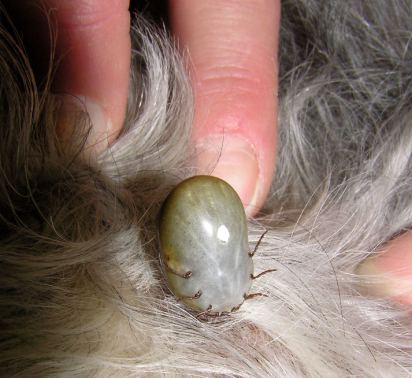This is the time of year that your pooch may pick up a free loader! You don’t have to go away to the country for your dog to pick up a tick. Even in London, on Hampstead Heath and indeed in your own garden it can happen!
What are Ticks
Ticks are blood-sucking parasites, fortunately less dangerous in the UK than in some foreign countries. However ticks bite both humans and animals and can cause diseases and local infection – after mosquitoes ticks are the second most common insect to transmit diseases to animals. For this reason it’s very important to know how to recognize a tick and how you can prevent them harming your pets.

Sheep ticks are commonly found in long grasses, moorland and woodland where sheep have been grazed. Hedgehog ticks can be found in your garden. The first sign you will see on your pet is a small grey dot attached to your pet’s skin. The tick will grow larger as it feeds on your pet’s blood – to the size of a pea or bean .
All ticks should be removed as soon as possible.
Tick Control
Control and prevention of ticks is extremely important in reducing the risk of disease associated with ticks. This includes removing the ticks as soon as possible and trying to prevent attachment.
- Discuss prevention with your vet – pets which come into contact with sheep grazing areas or hedgehogs should be treated regularly to prevent infestation
- Groom your dog thoroughly every day and check skin. Thorough grooming may brush out a tick from your dog’s fur before it buries it’s mouth parts in the skin. The inside of the ear, the groin and the head are favourite spots for ticks.
Natural Tick Control
•Garlic – I am a great believer of Garlic spray from dorwest herbs in helping to prevent parasites. Garlic can also be brought in tablet form from Dorwest and added to the diet as directed. With the tablets the smell is excreted through the skin and repels both ticks and fleas. However, garlic contain sulfoxides and disulfides, which can damage red blood cells and cause anemia in dogs so make sure you follow the given guidelines .
•Apple Cider Vinegar – Apple cider vinegar adds acidity to your dog’s blood, making it less appealing to ticks and fleas. Add 2 tablespoons of the apple cider vinegar to the dog’s food or water bowl as a preventative.
Tick Removal
IF YOU ARE SQUEAMISH OR NOT 100% SURE YOU CAN MANAGE SUCCESSFULLY TO REMOVE THE WHOLE OF AN ATTACHED TICK YOURSELF – INCLUDING IT’S BURIED MOUTH PARTS:
**TAKE YOUR DOG TO THE VET**

· The best recommendation to remove a tick is to use a commercially available tick removal device and pull the tick off.( e.g Mikki Tick Picker is excellent)
· Do not touch the tick since diseases can be transmitted. Consider wearing gloves when removing a tick.
· Apply some alcohol to the tick e g, neat whisky or gin, surgical spirit or even nail varnish remover. With a tick removal device, grab the tick as close to the head as possible. With steady, gentle pressure, pull the tick out of the skin. Frequently, pieces of skin may come off with the tick.
If the head of the tick remains in the skin, try to grab it and remove as much as possible. If you are unable to remove the entire head, your dog’s immune system will try to dislodge the head by creating a site of infection or even a small abscess.
Usually no additional therapy is needed, but if you are concerned, contact your vet. There are surgical instruments that can be used to remove the remaining part of the tick.
Copyright Tip Top Dog School 2009 at tiptopdogschool.blogspot.com

